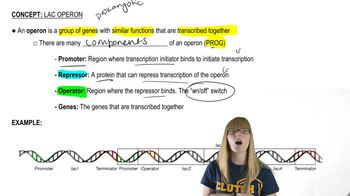The locations of numerous lacI⁻ and lacIˢ mutations have been determined within the DNA sequence of the lacI gene. Among these, lacI⁻ mutations were found to occur in the 5′-upstream region of the gene, while lacIˢ mutations were found to occur farther downstream in the gene. Are the locations of the two types of mutations within the gene consistent with what is known about the function of the repressor that is the product of the lacI gene?
Table of contents
- 1. Introduction to Genetics51m
- 2. Mendel's Laws of Inheritance3h 37m
- 3. Extensions to Mendelian Inheritance2h 41m
- 4. Genetic Mapping and Linkage2h 28m
- 5. Genetics of Bacteria and Viruses1h 21m
- 6. Chromosomal Variation1h 48m
- 7. DNA and Chromosome Structure56m
- 8. DNA Replication1h 10m
- 9. Mitosis and Meiosis1h 34m
- 10. Transcription1h 0m
- 11. Translation58m
- 12. Gene Regulation in Prokaryotes1h 19m
- 13. Gene Regulation in Eukaryotes44m
- 14. Genetic Control of Development44m
- 15. Genomes and Genomics1h 50m
- 16. Transposable Elements47m
- 17. Mutation, Repair, and Recombination1h 6m
- 18. Molecular Genetic Tools19m
- 19. Cancer Genetics29m
- 20. Quantitative Genetics1h 26m
- 21. Population Genetics50m
- 22. Evolutionary Genetics29m
12. Gene Regulation in Prokaryotes
Lac Operon
Problem 9
Textbook Question
What properties demonstrate that the lac repressor is a protein? Describe the evidence that it indeed serves as a repressor within the operon system.
 Verified step by step guidance
Verified step by step guidance1
The lac repressor is a protein because it is encoded by the *lacI* gene, which produces a polypeptide chain that folds into a functional protein. Proteins are products of gene expression, and the *lacI* gene's transcription and translation into the lac repressor demonstrate this property.
Proteins have specific binding capabilities, and the lac repressor binds specifically to the operator region of the lac operon. This binding is a hallmark of protein functionality, as it involves recognition of a specific DNA sequence.
Experimental evidence shows that the lac repressor can be purified and studied in vitro. When isolated, it retains its ability to bind to the operator DNA, further confirming its protein nature and its role in gene regulation.
The lac repressor's role as a repressor is demonstrated by its ability to inhibit transcription of the lac operon. In the absence of lactose, the repressor binds to the operator, preventing RNA polymerase from transcribing the downstream genes necessary for lactose metabolism.
When lactose (or its isomer allolactose) is present, it binds to the lac repressor, causing a conformational change that reduces the repressor's affinity for the operator. This allows RNA polymerase to access the operon and initiate transcription, providing evidence that the lac repressor regulates the operon in response to environmental conditions.
 Verified video answer for a similar problem:
Verified video answer for a similar problem:This video solution was recommended by our tutors as helpful for the problem above
Video duration:
2mPlay a video:
Was this helpful?
Key Concepts
Here are the essential concepts you must grasp in order to answer the question correctly.
Lac Operon
The lac operon is a well-studied model of gene regulation in bacteria, particularly E. coli. It consists of genes responsible for the metabolism of lactose, controlled by a promoter and an operator region. The operon is regulated by the presence or absence of lactose, which influences the binding of the lac repressor protein to the operator, thereby controlling transcription of the downstream genes.
Recommended video:
Guided course

Lac Operon Overview
Lac Repressor Protein
The lac repressor is a protein that binds to the operator region of the lac operon, preventing RNA polymerase from transcribing the downstream genes when lactose is absent. This protein is produced by the lacI gene and functions as a negative regulator. Its ability to bind to the operator is crucial for the operon's function, as it ensures that the genes are only expressed when lactose is available.
Recommended video:
Guided course

Proteins
Evidence of Repression
Evidence that the lac repressor serves as a repressor includes experiments demonstrating that the addition of lactose leads to the inactivation of the repressor, allowing transcription to occur. Additionally, genetic studies, such as mutations in the lacI gene that prevent repressor production, result in continuous expression of the lac operon, confirming the repressor's role in regulating gene expression in response to environmental conditions.
Recommended video:
Guided course

Arabinose Operon
Related Videos
Related Practice
Textbook Question
542
views


